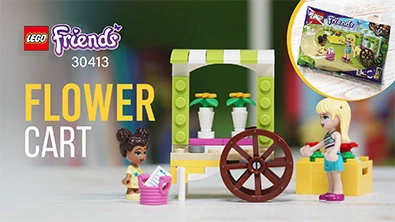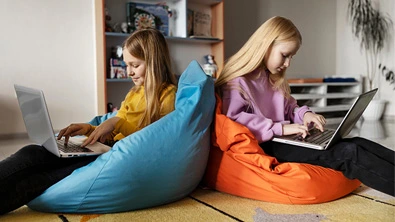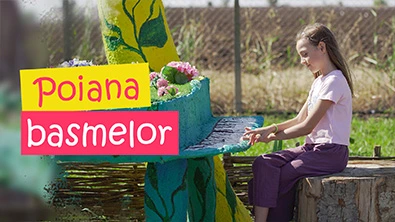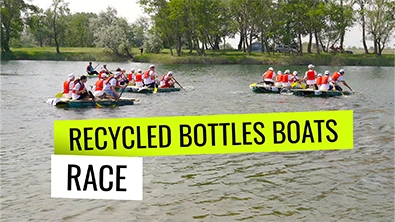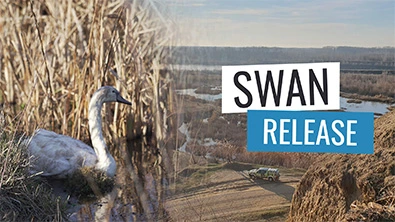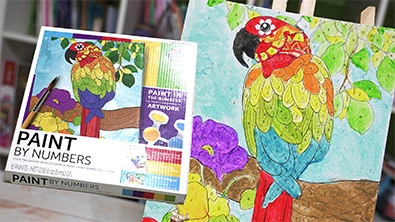Recycled Bottles Boats Race
This weekend we went to watch a boat race. The boats were made of plastic bottles.
This event has been coordinated by our friends from ACDB. Five teams with children from five different schools were there. After a short exercise session they started the competition. Ana and her friend held a gallery and enjoyed themselves with the participants.
This PET raft race provided the children with several opportunities for learning and personal development:
- creativity and innovative thinking: building a raft from PETs involved using available materials and creating a floating structure. The children learned to think creatively and find innovative solutions to make the raft as safe and functional as possible.
- environmental responsibility: using recycled PET to build rafts taught the children about the importance of recycling and reducing waste. They understood how their actions can have a positive impact on the environment and how to develop a sense of responsibility towards the conservation of natural resources.
- collaboration and teamwork: building and sailing a raft required close collaboration between the children. They learned to share ideas, work together and solve problems as a team. This will help them develop communication skills, learn to listen and rely on others.
- confidence and perseverance: participating in a raft race is a challenge for children. They had to overcome their fears and trust in their abilities. In addition, unpredictable situations arose during the race, and the children learned the importance of perseverance, finding solutions and not giving up in the face of obstacles.
- healthy competition and fair play: a raft race can be a fun competition between teams. Children learned to compete in a healthy and respectful way, to appreciate the success of others and to accept defeat with fair play.
Making a raft out of PETs (plastic bottles) can be an effective way to convey environmental protection and highlight the importance of recycling and waste reduction. This activity can be a great opportunity to teach children about the impact of plastic on the environment and how they can help protect it.
By turning plastic bottles into a cork, children learn that materials can be reused for creative and practical purposes, instead of being thrown away and contributing to environmental pollution. This activity can help raise children’s awareness of the amount of plastic waste generated and its impact on the environment. By turning PETs into a useful and fun object, children learn that every individual action to reduce plastic waste matters and can make a difference.
Making a raft from PETs can be an opportunity to discuss the impact of pollution on the environment and everyone’s responsibility to protect it. Children can understand that their actions have consequences and that they can contribute to a cleaner and healthier environment by making responsible choices.
Children can be encouraged to come up with ingenious ideas and solutions to turn plastic bottles into a functional cork. It can promote critical thinking and problem-solving skills, as well as an appreciation of resources and the possibilities offered by recycling and reuse. It is important to emphasize that making a cork from PETs is just one example of an activity and that there are many other ways we can convey environmental protection to children. It is beneficial to encourage their active involvement in such activities and give them a clear perspective on the importance of protecting the environment for future generations.
Because the outcome of the raft race is unpredictable, it can bring a sense of excitement and adventure. Participating in such unpredictable activities can be fun and provide opportunities for learning and personal development, such as quick decision making, teamwork and risk management.
In a raft race, there are many external factors that can influence the outcome and can be difficult to predict. These factors include current speed and direction, wind, waves and other weather conditions. These elements can vary and change throughout the course of the race, making it difficult to predict the final outcome.
The performance and outcome of the race may depend on the skills and strategies of the crew. Each crew may have different levels of experience and skill in navigating and controlling the raft. Also, the strategies adopted regarding navigation and obstacle avoidance may vary between crews. These aspects can contribute to the variability of the results and the unpredictability of the race.
During the raft race, various unforeseen obstacles and challenges may arise. These may include rocks or tree trunks in the water, strong currents, bends or artificial obstacles placed in the course. How the crew reacts and adapts to these obstacles can influence the final outcome and introduce an element of unpredictability into the race.
In a multi-raft race, the interaction with the other teams can bring an element of unpredictability. Crews can try to outdo each other, compete for advantageous positions, or try strategic maneuvers to secure a competitive advantage. This interaction can introduce unforeseen elements and influence the final result.
It is beneficial for a child to be involved in activities that involve unpredictable elements for several reasons:
- Developing adaptability: Participating in unpredictable activities helps children develop the ability to adapt and cope with new and unforeseen situations. This gives them the opportunity to expand their comfort zone and become familiar with uncertainty, which will be useful in life.
- Improving resilience: Unpredictable activities can bring unexpected challenges and obstacles. They give children the opportunity to develop resilience and learn to cope with failure or disappointment. By overcoming these situations, children learn to find solutions, adapt and keep moving forward.
- Stimulating creativity and critical thinking: Unpredictable activities encourage lateral thinking and creativity. Children need to put their imaginations to work to find solutions or adapt to unexpected situations. This helps them develop their critical thinking and problem solving skills.
- Learning flexibility and spontaneity: Unpredictable activities teach children to be flexible and adapt to change. They take them out of their routine and challenge them to find solutions in real time. This teaches them to put their plans aside and enjoy the present moment.
- Developing self-confidence: Succeeding in the face of unpredictable challenges can help develop self-confidence and self-esteem. Children learn that they can cope with unexpected situations and overcome obstacles, which helps them build confidence in their own abilities.
It is important that unpredictable activities are developmentally appropriate for the child and take place in a safe and supervised environment. It is also recommended that these activities be balanced with elements of predictability and routine, to give the child a sense of security and stability.
Studies show that involving children in nature activities can help reduce screen time. When children spend time in nature, they are engaged in active and interactive activities that give them opportunities to explore, move and play in their environment.
There are several reasons why engaging in outdoor activities can lead to decreased screen time:
- The Natural Attraction of Nature: Children are often fascinated by nature and all that it has to offer. Being in the middle of nature, they are tempted to explore, play and discover new things, which can lead them to forget about their monitors for a while.
- Physical activities and outdoor play: In nature, children have the opportunity to move, play and practice their motor skills. For example, they can run, climb, play football or ride a bike. These physical activities and outdoor games keep them busy and encourage them to spend less time in front of screens.
- Diversity of nature activities: Nature activities can be extremely diverse and interesting. These can include forest walks, mountain hikes, building a branch fort or bird and wildlife watching. These immersive and interactive experiences can rival the appeal of monitors and get kids to spend time outdoors.
- Mental and emotional health benefits: Studies show that spending time in nature can have beneficial effects on children’s mental and emotional health. Nature has a calming and relaxing effect, reducing stress and anxiety. These benefits can lead kids to ditch their monitors and spend more time outdoors.
It is important to emphasize that it is not necessary to completely eliminate the use of monitors, but rather to encourage a healthy balance between outdoor activities and the use of electronic devices. It is advisable to set limits on screen time and provide attractive and interesting outdoor alternatives to get children involved in nature activities.



